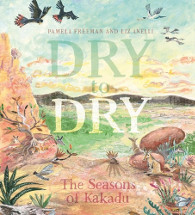Dry to dry: the seasons of Kakadu by Pamela Freeman

Illus. by Liz Anelli. Walker Books, 2020. ISBN: 9781760650285. 32pp.
(Age: 5+) Recommended. Another in the series of Nature
Storybooks published by Walker Books invites readers to 'delve
into the natural world'. This series of books promises that 'every
wonderful word is true' as a story develops in one font while the
facts are given in a more formal style in a different font, usually
placed at the bottom of the page. With a substantial index, and
extra information at the back of each book, they support
environmental work in any classroom while encouraging younger
readers to be dazzled by the world in which they live.
Dry to dry shows us the two main seasons of Kakadu in
Australia's north. This huge wetland, now a national park of world
heritage status, supports at least 280 bird species, while many
animals known to environmentalists across the world live there.
The book opens and finishes with the dry, and we see and read of the
animals that survive during the two seasons and how they live in
such conditions. Packed within a couple of paragraphs on each page
is an enormous amount of information, told in tight, sparse prose.
Several pages along, the lightning strikes begin with the cockatoos
headed for their roost before the rain. These rains only start the
creeks flowing again, it is later that the wet comes, filling them
to the brim, overflowing into the land beyond, until Kakadu becomes
a wetland. A range of animals is mentioned, frogs that provide food
for predators, crocodiles looking for frogs and crustaceans, a
myriad of birds, some flying in from the Arctic, some from closer
realms, jabiru with its nest high in the banyan tree, while during
the downpour, snakes and goannas seek higher ground in the same
tree.
But then the rains cease and the heat bears down, drying up the
wetlands, creeks recede to waterholes, the waterholes sink beneath
the ground, the turtles bury themselves waiting for the wet to come
agin.
At the end, alongside a page of information about Kakadu, a page is
devoted to the Aboriginal way of dividing Kakadu's seasons. They
distinguish six seasons and these are explained with their Kakadu
word and given a reference to the book's pages.
This lovely book, full of information accessible to younger readers
fits alongside other Kakadu books such as Walking with the
seasons at Kakadu (Allen & Unwin, 2003) Kakadu calling
(Magabala, 2013) and My home in Kakadu (Magabala, 2006).
The mixed media illustrations are stylish and impressionistic,
colours muted and understated, and children will enjoy looking for
the many animals, birds and plant life shown. Some are given with
flair, an impression rather than a detailed examination, while
others are more carefully drawn, giving children a more precise
picture of the animal shown. I can imagine children getting out
other books about Australian flora and fauna to identify some of the
animals and plants shown. I love the glimpses of human life, the
tour bus, the kids playing around the termite mounds, the bird hide,
road signs, campervan and river cruise.
And I was overjoyed to see a pair of maps indicating where Kakadu is
on the continent of Australia and a closer map of Kakadu National
Park. Teacher's
notes are also available.
Themes: Aboriginal life, Kakadu, Northern Territory, Environment,
Animals, Birds.
Fran Knight